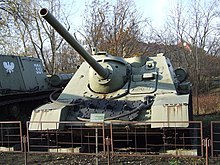Spherical shutter
A spherical shield is a special form of armor protection, which is used in the military sector in tanks or fortresses as well as in the civil sector.
Development history
The spherical screen was first developed for fortresses. It was found that a ball joint offered more freedom of movement. In some bunkers were embrasures provided with a rolling mechanism. A metallic, spherical head was inserted into this mechanism. This head contained devices to accommodate a rifle or machine gun . Aiming devices were placed in the spherical diaphragm. This installation reduced the blind spot in the defense of the fortress, as the barrel of the weapon could now protrude from the bunker. This enabled a tighter defense for fortresses. After the fortress became obsolete as a weapon, the spherical screen disappeared in this area.
Application in tank technology
Typical examples of the use of the spherical shield in tank construction during the Second World War are the Russian SU-85 and SU-100 assault guns and the bow machine guns of almost all German battle tanks, which were stored in spherical shields. Another possibility of armor protection of the weapon mount was the roller cover and the Saukopf cover . With modern warfare and combined arms combat , the ball aperture made a comeback. Soldiers were driven into the combat zone in armored personnel carriers and were supposed to fight here dismounted. The soldiers were protected in the armored personnel carrier until they reached the deployment site. However, they could not intervene in the action. So it was decided to reintroduce the ball diaphragm. It was installed in the combat area of the armored personnel carrier and thus offered all or some soldiers the opportunity to actively participate in the fire fight until the vehicle was left (dismounted). Well-known tank models with a spherical aperture are the M2 Bradley or the Marder .
Civil use
In the civil sector, the ball diaphragm is mainly used when sensitive areas, such as laboratories, are affected. It offers a robot arm enough freedom to move, but protects the technicians behind it who operate these arms. For example in computer technology, where absolutely sterile rooms are required in places. On the control levers of a model remote control or a (truck) crane, which are used outdoors and should be very easy to move. The technical ball joint is a further development.
literature
- Roger Ford, tanks from 1916 to the present day , Karl Müller Verlag, Erlangen, ISBN 3-86070-676-4
